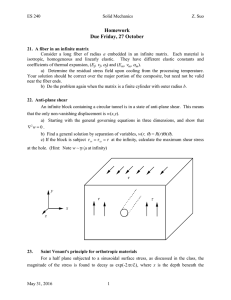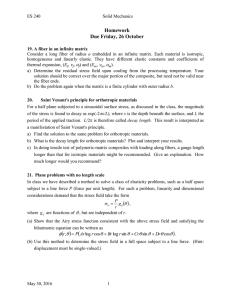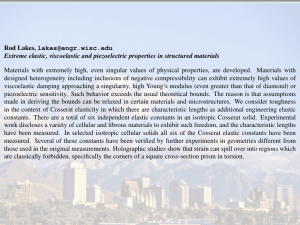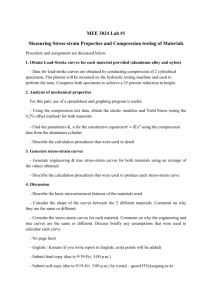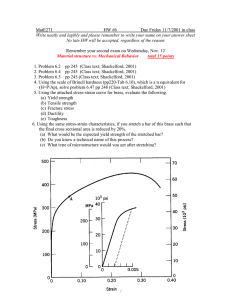ν α ES 240 Solid Mechanics
advertisement
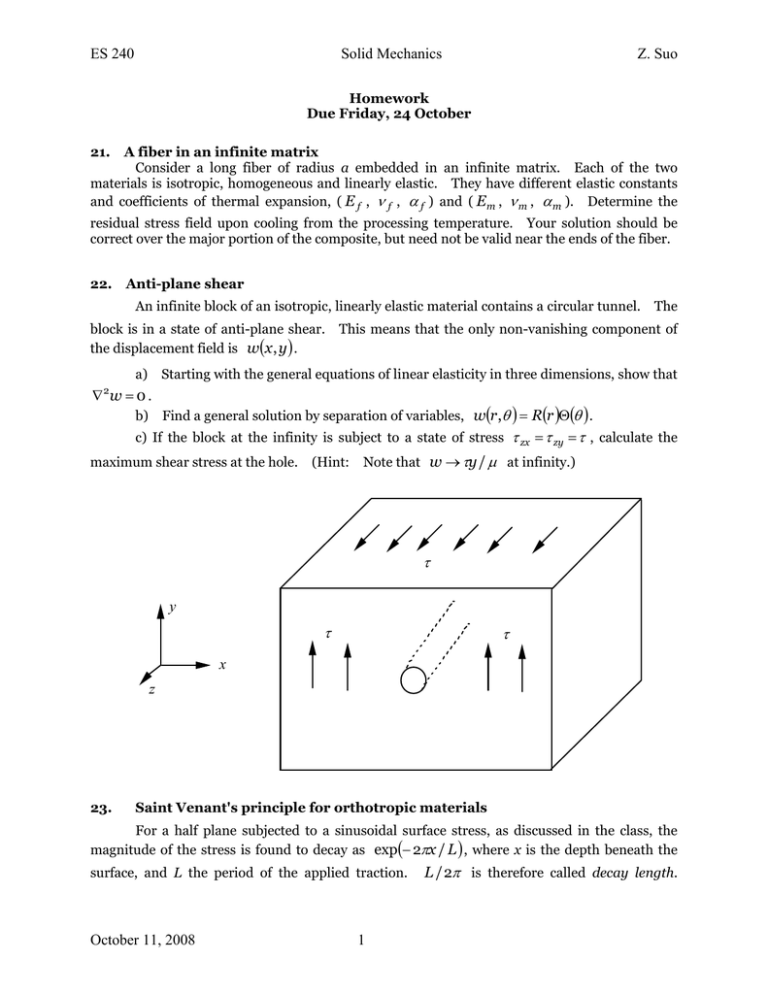
ES 240 Solid Mechanics Z. Suo Homework Due Friday, 24 October 21. A fiber in an infinite matrix Consider a long fiber of radius a embedded in an infinite matrix. Each of the two materials is isotropic, homogeneous and linearly elastic. They have different elastic constants and coefficients of thermal expansion, ( E f , ν f , α f ) and ( Em , ν m , α m ). Determine the residual stress field upon cooling from the processing temperature. Your solution should be correct over the major portion of the composite, but need not be valid near the ends of the fiber. 22. Anti-plane shear An infinite block of an isotropic, linearly elastic material contains a circular tunnel. block is in a state of anti-plane shear. the displacement field is w(x , y ) . a) The This means that the only non-vanishing component of Starting with the general equations of linear elasticity in three dimensions, show that 2 ∇ w =0. b) Find a general solution by separation of variables, w(r ,θ ) = R(r )Θ(θ ) . c) If the block at the infinity is subject to a state of stress τ zx = τ zy = τ , calculate the maximum shear stress at the hole. (Hint: Note that w → τy / µ at infinity.) τ y τ τ x z 23. Saint Venant's principle for orthotropic materials For a half plane subjected to a sinusoidal surface stress, as discussed in the class, the magnitude of the stress is found to decay as exp(− 2πx / L ) , where x is the depth beneath the surface, and L the period of the applied traction. October 11, 2008 1 L / 2π is therefore called decay length. ES 240 Solid Mechanics Z. Suo This result is interpreted as an example of Saint Venant's principle. a) Find the solution to the same problem for orthotropic materials. b) What is the decay length for orthotropic materials? c) In doing tensile test of polymeric-matrix composites with loading along fibers, a Plot and interpret your results. gauge length longer than that for isotropic materials might be recommended. explanation. 24. Give an How much longer would you recommend? Plane problems with no length scale In class we have described a method to solve a class of elasticity problems, such as a half space subject to a line force P (force per unit length). For such a problem, linearity and dimensional considerations demand that the stress field take the form σ ij = P gij (θ ) , r where g ij are functions of θ , but are independent of r. (a) Show that the Airy stress function consistent with the above stress field and satisfying the biharmonic equation can be written as φ (r ,θ ) = P ( Ar log r cos θ + Br log r sin θ + Crθ sin θ + Drθ cos θ ) . (b) Use this method to determine the stress field in a full space subject to a line force. (Hint: 25. displacement must be single-valued.) More scaling relations: a half space filled with a power-law material Beyond the linearly elastic range, metals and polymers can often be described with a power-law stress-strain relation. The stress-strain relation under uniaxial tension may be written as σ = Kε N , where K (a quantity of dimension of stress) and N (a dimensionless number) are parameters used to fit the stress strain relation experimentally measured for a given material. We can then generalize this uniaxial stress-strain relation to a multi-axial stress-strain relation: σ ij = Kf ij (ε 11 , ε 22 ,...) . To preserve the power law, we stipulate that f ij are homogenous functions of power N. That is, for any number λ , the following identity holds: f ij (λε 11 , λε 22 ,...) = λN f ij (ε 11 , ε 22 ,...) . Of course, linear elasticity is a special case. (Some people may recognize that the J 2 deformation theory produces such a multi-axial stress-strain relation.) Now imagine that a power-law material fills a half space, on the surface of which is applied a concentrated force F. October 11, 2008 2 ES 240 Solid Mechanics Z. Suo (a) List all governing equations of this three-dimensional boundary value problem. (b) Let (r ,θ ,φ ) be a spherical coordinate centered at the point where the concentrated force F is applied. Show that the stress, strain, and displacement fields take the following form σ ij = F gij (θ ,φ ) r2 ⎛ F ⎞ ε ij = ⎜ 2 ⎟ ⎝ Kr ⎠ ⎛ F ⎞ ui = ⎜ 2 ⎟ ⎝ Kr ⎠ where gij , hij 1/ N 1/ N hij (θ ,φ ) rki (θ ,φ ) and ki are dimensionless functions of (θ ,φ ) . These functions are independent of r, F and K, but may depend on N and other dimensionless parameters that specify the stress-strain relation. October 11, 2008 3
